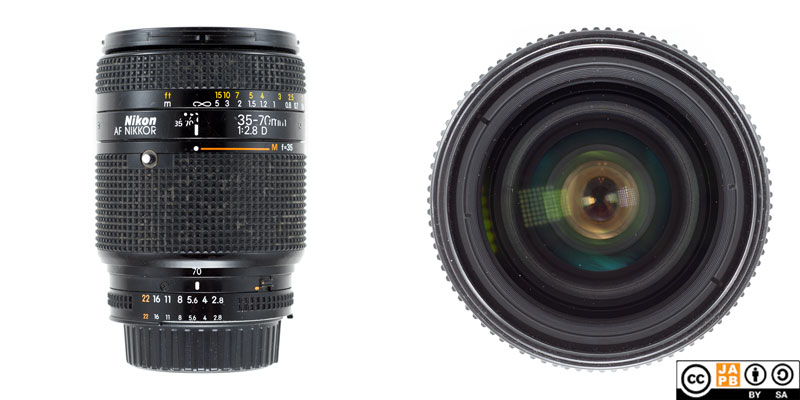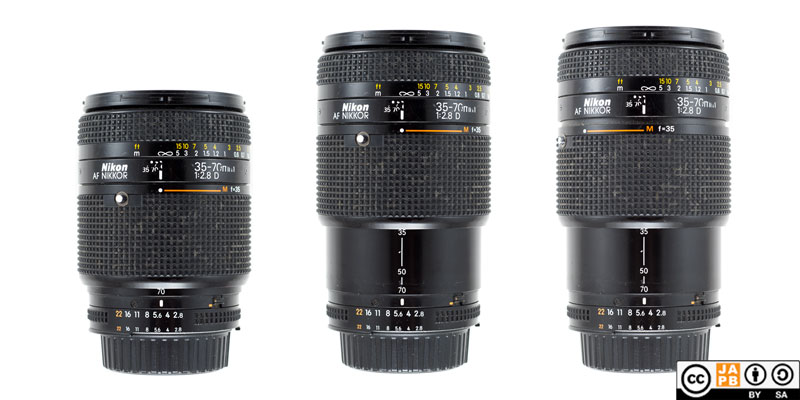Pekka Buttler, 02/2024
Note please: Both there are two optically and cosmetically identical versions of this lens:
• Nikkor AF 35-70mm f/2.8 (1987–1992)
• Nikkor AF-D 35-70mm f/2.8 (1992–2005)
(see more under ‘versions‘).
As the differences are minute, this one data sheet will address both versions.

Specifications
The table below summarises the lens’ key specifications of both versions (measurements based on pictured sample).
| Brand: | AF Nikkor | Lens name | 35-70mm 1:2.8 D |
| Focal length(s)1 | 35–70 mm | Angle-of-view2 | 62°–34°20 |
| Maximum Aperture | f/2.8 | In Production | AF 1987–1992 AF-D 1992–2005 |
| Lens mount | Nikon F | Subfamily (if applicable) | AF/AF-D |
| Length3 | 94,8 mm | Diameter4 | 71,4 mm |
| Filter ring diameter | 62 mm | Weight | 667 grams |
| Lens element count | 15 | Lens group count | 12 |
| Aperture blades (S/R/C)5 | 7 S | Focus throw | ≈70 ° |
| Minimum focusing distance | 60 cms | Maximum magnification | 1:7,7 |
| Has manual aperture ring | YES | Has Manual focus ring | YES |
| Aperture mechanism type | Automatic | Aperture click stops 6 | 2.8-4-5.6-8-11-16-22 |
Historical notes
• When Nikon introduced its autofocus system (the F-501 camera and AF lenses) in 1996, they initially introduced 6 primes (from 24–300 mm), one tele zoom (the 70-210/4 [data sheet]), one macro lens, one autofocusing teleconverter and four lenses corresponding to the definition of a standard zoom:
– Nikkor AF 35–70 mm f/3.3–4.5 [data sheet]
– Nikkor AF 35-105 mm f/3.5–4.5 [data sheet]
– Nikkor AF 35–135 mm f/3.5–4.5 [data sheet]
– Nikkor AF 28–85 mm f/3.5–4.5 [data sheet]
• While there was a clear pecking order between these standard zooms, none of these were targeted at pro users. That omission was rectified in 1987 – one year after introduction of the Nikon AF system – with the introduction of the 35–70/2.8 (this lens).
• On its introduction, the Nikkor AF 35–70/2.8 was Nikon’s first pro-level zoom for its new autofocus system, the Nikon’s first standard zoom with a maximum aperture of f/2.8 and only Nikon’s second zoom with such a bright maximum aperture7.
• It is important to refer to this as the 35–70/2.8 as Nikon also simultaneously offered a 35–70mm f/3.3–4.5 consumer grade zoom [data sheet].
Further notes

Middle: Nikkor AF 35–70mm f/2.8 Zoomed to 35 mm
Right: Nikkor AF 35–70mm f/2.8 Zoomed to 35 mm, in macro mode
• The lens is a two-ring push/pull zoom. The zoom ring moves forward and back to change focal length while the focusing ring rotates to change focus. The lens is at its shortest at the 70 mm setting and lengthens considerably when zooming out to 35 mm.
• The lens’ length also changes when focusing, and the filter thread does rotate when focusing.
• The lens offers a macro mode that you can engage when the lens is zoomed to the 35 mm setting. In that macro mode MFD is 28 centimetres (which is not that little, until you consider that that is only 5 cm from the lens’ front element) and it gives you a maximum magnification of 1:4.
• This lens was the pro standard zoom in the Nikon system until it was dethroned in 1999 by the AF-S 28–70 D IF-ED. Even so, the 35–70/2.8 remained in production all the way until 2005.
• Nikon did offer a bayonet-mounted lens hood (the HB-1), but it is only limitedly useful.
Versions
This lens has no direct predecessor, although it served the same purpose in Nikon’s lineup as the Nikkor Ai-s 35–70 mm f/3.5 [data sheet]. Also, it had no direct replacement, but its role was taken over by the Nikkor AF-S 28–70 D IF-ED in 1999.
There are three versions of the Nikkor 35–70 mm f/2.8. All versions are cosmetically and optically identical. See table below for details.
| years | serials: | D-type | D-chip type | |
| AF 35–70 mm f/2.8 | 1987-1992 | 200001–329846 | No | N/A |
| AF-D 35–70 mm f/2.8 | 1992-1993 | 400001–420572 | Yes | old |
| AF-D 35–70 mm f/2.8 | 1993-2005 | 600001–837839 | Yes | new |
A brief genealogy of Nikon SLR lens types
Nikon is undoubtedly one of the great names in 35 mm SLR photography. The Nikon F mount has been in continuous production since 1959. During that time, the mount has developed/changed in some detail, however without ever fully sacrificing compatibility.
In short (a longer version is here), the development of Nikon’s SLR lenses can be traced as follows:
• 1959–1977: Pre-Ai. Manual focus lenses that use ‘rabbit ears’ to communicate selected aperture with the camera body.
• 1977–1986: Ai and Ai-s. Manual focus lenses that may have ‘rabbit ears’ for backward compatibility, but are designed to communicate selected aperture with the camera body through indentations in base of aperture control ring.
• 1986–today: AF and AF-D. Autofocus lenses that do not have a focusing motor within the lens, but rely on the focus motor within the camera. All AF and AF-D lenses are simultaneously Ai-s lenses (they are Ai-s lenses extended with AF) 8
• 1996–today AF-S and AF-P. Autofocus lenses that have an internal focusing motor and do not rely on the body having a focusing motor.
Adapting
Besides adapting, this lens can be used natively on all current high-end Nikon dSLRs and several earlier medium-to-high-end older Nikon dSLRs. Moreover, if the camera body contains a slot-drive focusing motor, this lens will even auto-focus9. Likewise, if the lens has been retrofitted with ‘rabbit ears’, it can be natively used on all Nikon F-mount film cameras ever produced (without the rabbit ears, it is limited to post-1977 bodies).
Thanks to being a fully manual lens (manual aperture, manual focus), the lens can be adapted to all mirrorless cameras using a suitable dumb adapter (and such adapters are easy to find). Moreover, a large range of special adapters (helicoid adapters, tilt/shift adapters, speed boosters) for using Nikon F lenses on most mirrorless systems are available. Currently no adapters for mirrorless exist that would allow autofocus through the slot-drive screw.
Using Nikon F lenses on non-Nikon SLRs and dSLRs is likewise a distinct possibility. Thanks to the relatively generous flange focal distance of the Nikon F mount (46,5 mm), adapter rings for all dSLR mounts are available as well as for a goodly portion of film-era SLR mounts. Such rings will not allow autofocus, and are unlikely to support auto aperture, but even then the lenses can be used in stop-down metering mode.
Footnotes
- Focal length is (unless stated otherwise) given in absolute terms, and not in Full-frame equivalent. For an understanding of whether the lens is wide/tele, see ‘Angle-of-view’. ↩︎
- Picture angle is given in degrees and concerns the diagonal picture angle. Rule of thumb:
> 90 ° ==> Ultra-wide-angle
70–90 ° ==> Wide-angle
50–70 ° ==> Moderate wide-angle
40–50 ° ==> ‘Standard’ or ‘normal’ lens
20–40 ° ==> Short tele lens
10-20 ° ==> Tele lens
5-10 ° ==> Long tele lens
< 5 ° ==> Ultra-tele lens ↩︎ - Length is given from the mount flange to the front of lens at infinity. ↩︎
- Diameter excludes protrusions such as rabbit ears or stop-down levers. ↩︎
- S=straight; R=rounded; C=(almost)circular at all apertures. ↩︎
- Numbers equal aperture values on aperture ring; • intermediate click; – no intermediate click. ↩︎
- Nikon’s first f/2.8 zoom was the Ai-s 80–200/2.8 ED lens manufactured between 1982–1985. While revolutionary, it was both bulky and very expensive. Hence, only ≈1500 were manufactured. ↩︎
- There is a further sub-class of AF-D lenses called AF-I lenses that are otherwise AF-D lenses (meaning, fully Ai-s compatible), but have an internal focus motor. Only long tele lenses were made in AF-I variants. ↩︎
- As of this writing, the following Nikon dSLRs fully support autofocus, aperture priority and manual metered modes on Nikkor AF/AF-D lenses: D2, D3, D4, D5, D6, Df, D200, D300, D300s, D500, D600, D610, D700, D750, D780, D800, D800E, D810, D850, D7000, D7100, D7200 ↩︎